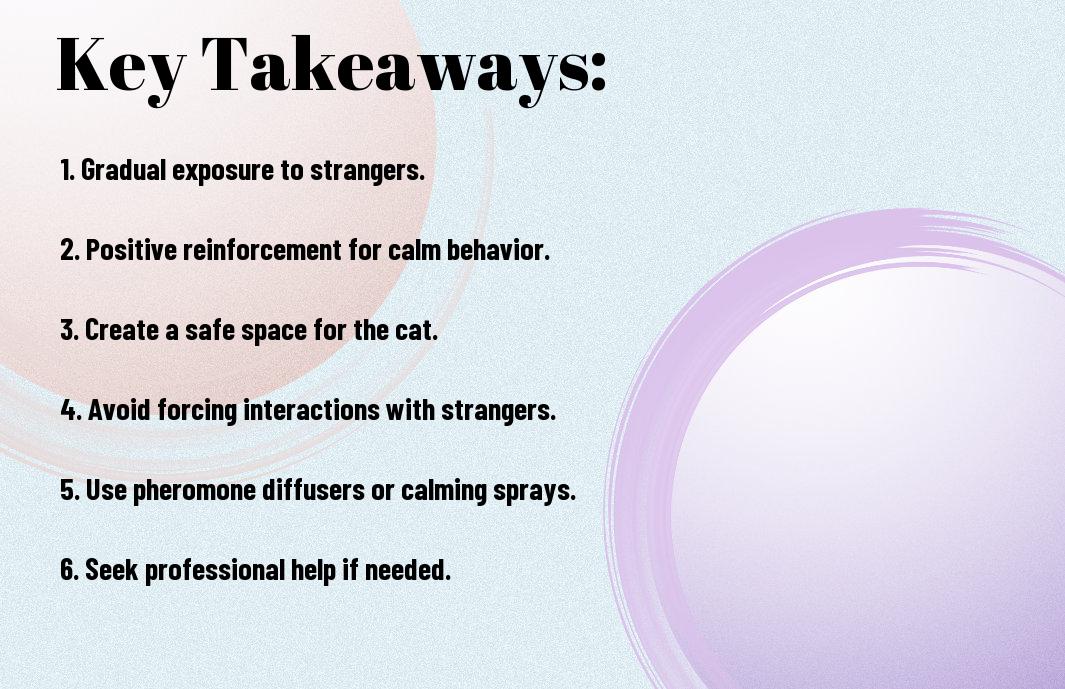Do you often find your cat exhibiting fear or anxiety when new people come into your home? It’s important to remember that cats are territorial animals, and adjusting to unfamiliar faces and scents can be stressful for them. However, there are several methods you can use to help ease your feline friend’s anxiety and promote a more relaxed demeanor around strangers. From gradual exposure to positive reinforcement, learning to read your cat’s body language, and creating safe spaces, it’s important to approach this training process with patience and care. In this blog post, we will explore some effective techniques for helping your cat feel more at ease in the presence of new people.
Key Takeaways:
- Positive Reinforcement: Use treats or toys to reward your cat for calm behavior around strangers, gradually building trust and confidence.
- Gradual Exposure: Introduce your cat to new people in a controlled, calm environment, allowing them to adjust at their own pace.
- Safe Spaces: Provide your cat with a designated area where they can retreat to when feeling overwhelmed by unfamiliar visitors.
- Patience and Consistency: Understand that training a cat to be relaxed around strangers takes time, and it’s important to be consistent with the training methods you use.
- Playtime and Exercise: Engage your cat in interactive play and provide plenty of opportunities for physical activity to help reduce overall stress and anxiety.

Training Methods for Relaxation
Assuming your cat is fearful or anxious around strangers, there are several training methods you can implement to help them relax and feel more at ease in the presence of unfamiliar people. It’s important to take a gradual approach and use patience, consistency, and positive reinforcement to achieve the best results. Here are some effective training methods that can help your cat become more comfortable around strangers.
Desensitization Techniques
Desensitization involves slowly exposing your cat to situations that trigger their fear or anxiety, such as the presence of strangers, in a controlled and positive way. You can start by keeping your cat in a separate room when you have visitors and gradually allowing them to be in the same space as the strangers for short periods of time. You can also use treats and toys to create positive associations with the presence of strangers. For more detailed guidance on desensitization techniques, check out 3 Ways to Break Your Cat’s Cycle of Xenophobia (Fear of Strangers).
Positive Reinforcement Strategies
Using positive reinforcement is crucial in training your cat to be more relaxed around strangers. Whenever your cat displays calm and relaxed behavior in the presence of strangers, make sure to praise and reward them with their favorite treats or toys. This will help reinforce the idea that remaining calm around strangers leads to positive outcomes. Avoid punishing or scolding your cat for being fearful as this can exacerbate their anxiety. It’s important to create a safe and supportive environment for your cat to encourage positive associations with the presence of strangers.
Environmental Adjustments
Despite your best efforts to train your cat to be more relaxed around strangers, sometimes they need a little extra help. Making adjustments to their environment can create a sense of security and ease their anxiety when encountering new people.
Creating a Safe Haven
One effective method for helping your cat feel more relaxed around strangers is to create a safe haven for them. This could be a cozy, secluded spot in your home where they can retreat to when they feel overwhelmed or anxious. Make sure this area is equipped with their favorite toys, bedding, and a scratching post to help them feel comfortable and secure. You can also provide them with a tall cat tree or shelves to climb on, giving them a safe vantage point to observe unfamiliar visitors from a distance.
Use of Pheromones and Calming Aids
Another option for helping your cat feel more at ease is the use of pheromones and calming aids. Products such as synthetic pheromone diffusers or sprays can help create a calming atmosphere in your home, reducing your cat’s stress levels. Additionally, there are natural supplements and treats available that contain calming ingredients such as L-theanine and chamomile, which can be effective in helping to relax your cat in stressful situations.

Handling and Interaction Tips
Lastly, here are some handy handling and interaction tips to help train your cat to be more relaxed around strangers:
- Be patient and gentle, your cat may need time to get used to new people
- Provide a safe space for your cat to retreat to if feeling overwhelmed
- Always supervise interactions between your cat and strangers
- Use positive reinforcement in the form of treats or toys when your cat reacts calmly to strangers
Perceiving your cat as an individual with unique needs and preferences can make a huge difference in how well they respond to training efforts.
Gradual Introduction to Strangers
If your cat is particularly skittish around strangers, gradually introducing them in a controlled environment can help. Start by having the stranger simply in the same room without making direct eye contact or sudden movements. Over time, you can increase the interaction when your cat becomes more comfortable.
Encouraging Gentle Handling
It’s important to show strangers how to handle and pet your cat gently. This not only helps your cat feel more at ease but also prevents any potential injury from a scared or defensive reaction. Teach them to approach slowly and to let your cat sniff their hand before attempting to touch them.
Monitoring Progress and Adjusting Techniques
After implementing the training methods for helping your cat relax around strangers, it is important to monitor their progress and adjust your techniques as needed. This will help ensure that you are effectively helping your cat overcome their anxiety and become more comfortable in social situations.
Recognizing Signs of Stress and Relaxation
It is crucial to pay attention to your cat’s body language and behavior to recognize signs of stress and relaxation. Signs of stress may include dilated pupils, flattened ears, hissing, or hiding. On the other hand, signs of relaxation may include slow blinking, purring, and a relaxed body posture. By being observant of these signs, you can gauge whether your training methods are working and make necessary adjustments.
Adapting Training Methods as Needed
If you notice that your cat is still exhibiting signs of stress around strangers despite your efforts, it may be necessary to adapt your training methods. This could involve taking a step back and allowing your cat more time to acclimate to social interactions, or trying different calming techniques such as using pheromone diffusers or creating safe spaces for your cat to retreat to. It’s important to be flexible in your approach and tailor your methods to suit your cat’s individual needs.

To wrap up
There are several effective methods for training your cat to be more relaxed around strangers. Consistency, positive reinforcement, and desensitization are key components to consider. By slowly introducing your cat to new people and rewarding calm behavior, you can help your feline friend become more comfortable in social situations. Additionally, providing a safe space for your cat to escape to when feeling overwhelmed can also help ease their stress. Remember, patience and understanding are essential when training your cat to be more relaxed around strangers.
FAQ
Q: What are some methods for training a cat to be more relaxed around strangers?
A: There are several methods that can help train a cat to be more relaxed around strangers. First, it’s important to provide a safe and comfortable environment for the cat to retreat to when feeling overwhelmed. Additionally, positive reinforcement techniques such as treats and praise can be used to reward calm behavior around strangers. Gradual exposure to new people in a controlled environment can also help desensitize the cat to unfamiliar individuals.
Q: Are there any specific training exercises that can help a cat become more at ease around strangers?
A: Yes, there are specific training exercises that can help a cat become more at ease around strangers. One technique is to practice “gentle handling” with the cat, which involves slowly and gently introducing the cat to being touched and handled by different people. This can help the cat become more accustomed to physical contact with strangers. Additionally, creating positive associations with strangers by having them offer treats or engage in interactive play with the cat can also be beneficial.
Q: Should I consult with a professional trainer for help in training my cat to be more relaxed around strangers?
A: If you are struggling to train your cat to be more relaxed around strangers, it may be beneficial to consult with a professional trainer or behaviorist who specializes in feline behavior. They can provide personalized guidance and support based on your cat’s specific needs and temperament. Additionally, a professional can help identify any underlying issues contributing to your cat’s discomfort around strangers and develop a tailored training plan to address these concerns.

Jayley, a devoted cat enthusiast, also writer for other cat blog as well. She aims to dedicated to providing comprehensive information, insights, and advice on everything you’d ever want to know about our whiskered companions.
